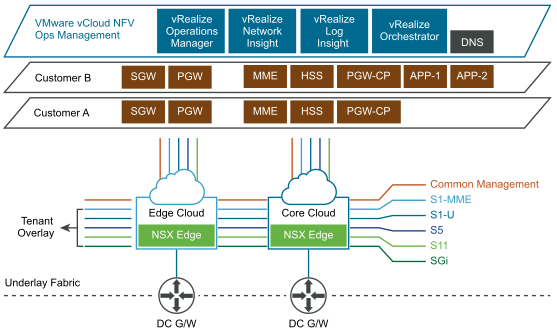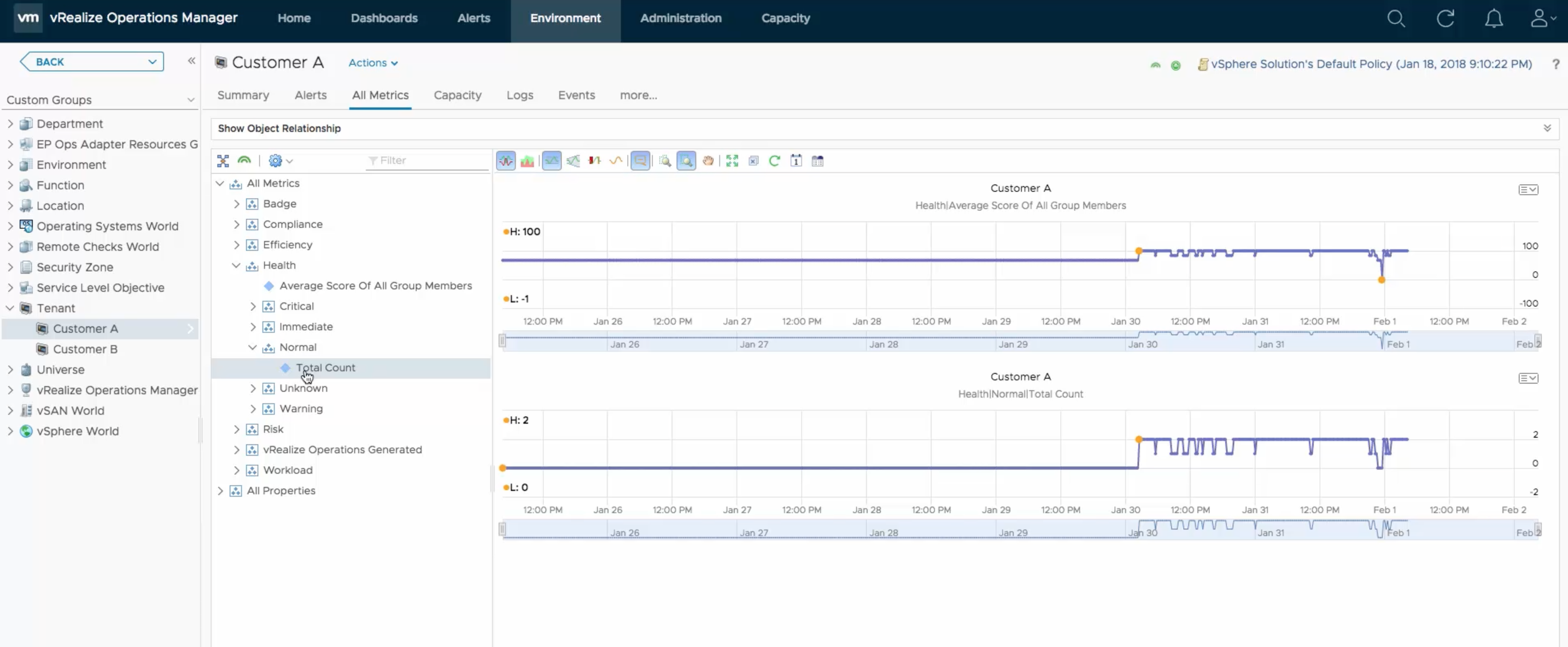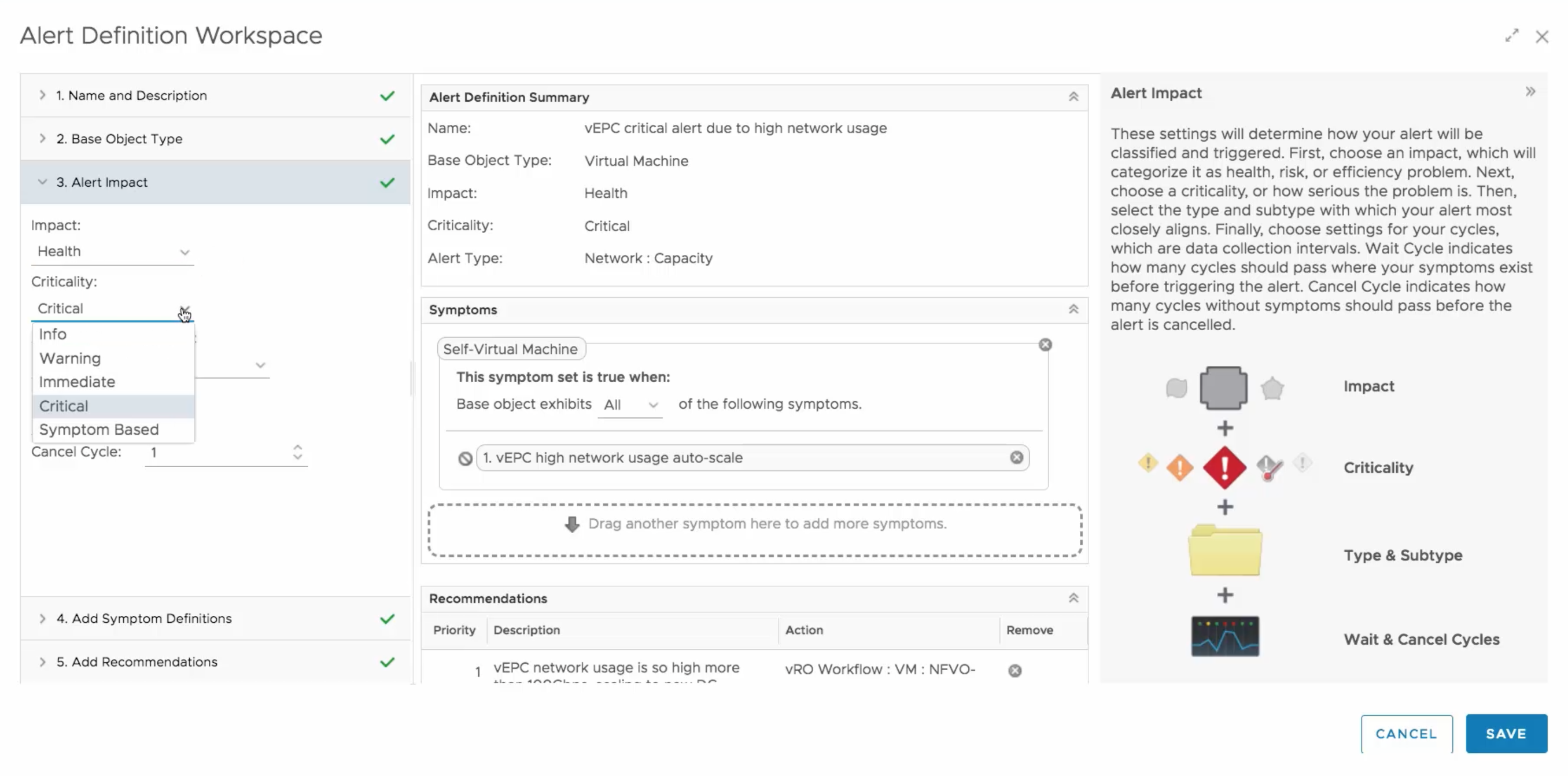The vCloud NFV OpenStack Edition operations management components are pre-configured with default dashboards, alerts, actions, and profiles. To make day 2 operations effective, additional steps for onboarding service operations are required so that to enhance the monitoring and remediation of the cloud infrastructure environment.
Consider the following topology as an illustration of a multi-tenant service offer of the mobile packet core:

The example topology places the data plane components of the packet core in the edge cloud while control plane functions in the core cloud, including the operations management components.
-
Access controls (RBAC).The CSP administrator should start by creating the user profiles, roles, and permissions within vRealize Operations Manager for their tenants. This way, tenant users are able to view dashboards and performance or fault information that the CSP administrator selects to expose.
-
Service definition. Once the VNFs are onboarded for the tenant, the CSP administrator can create service definitions within vRealize Operations Manager. In the example, an evolve packet core service definition is created by using a Service Group construct. If the VMs for the various VNFs are placed in vCenter Server folders, the CSP administrator can map them to a service group or select individual VMs for that tenant. The underlying compute, networking, and storage infrastructure components are auto-discovered for each VM. This includes parent containers such as clusters, datastores, and data center. Once the CSP administrator creates the service definitions, they can monitor the various performance counters, health, risk, efficiency, anomalies, and faults for the delivered services. Similarly, the CSP administrator can create service definitions in vRealize Network Insight to create the networking and security views of the tenant services.

-
Dashboards. All components of the operations management solution provide default and customizable dashboards. By using the library of widgets, the CSP administrator can create views for time-series, object-relationships, topologies, alerting, heat-maps, capacity, and so on.
-
Default Alerts. A key component for effective monitoring and remediation or the virtual environment is the rich customizable alerting framework that is available in the platform. Along with the numerous out-of-the-box alerts in the platform, the CSP administrator can also create service-centric alerts by using complex rules and machine learning across multiple VNFs. The framework allows the CSP administrator to create alerts on target object types and specify the impact depending on the risk, efficiency, and health. They can also create complex symptom definitions and a recommendation. The recommendation can be an informational message on how to remediated the alert, which can be tied to a semi-supervised or automated action the system can take. Timely action is key to ensure that QoS and SLA guarantees are met.

Action workflows. Action workflows trigger remediation for issue avoidance. Workflows can be internal to the NFVI layer or trigger an external element such a VNF-M or NFV-O. A transient spike in the packet core utilization might trigger a rebalance of the Packet Gateway (PGW) to mitigate congestion on the host. A workflow trigger to the DRS can be leveraged in such a scenario. For external triggering, vRealize Operations Manager is integrated with vRealize Orchestrator. Custom workflows and scripts can be defined in vRealize Orchestrator. They appear as actions in vRealize Operations Manager that can then be mapped in the alerting framework.
Cloud-Native Ready
vRealize Operations Manager can be further enhanced with a management pack for Kubernetes clusters that are deployed together in the multi-tenant NFVI environment. Once installed, the management pack for Container Monitoring can be configured by pointing to the Control Plane Node URL of the Kubernetes container and selecting the cAdvisor service. vRealize Operations Manager collects metrics for nodes, pods, and containers and applies the same class of assurance for discovery, monitoring, and analytics. For more information, see vRealize Operations Management Pack for Container Monitoring.
For more information on configuring and customizing the components, refer to the official documentation for vRealize Operations Manager, vRealize Log Insight, vRealize Network Insight, and vRealize Orchestrator.